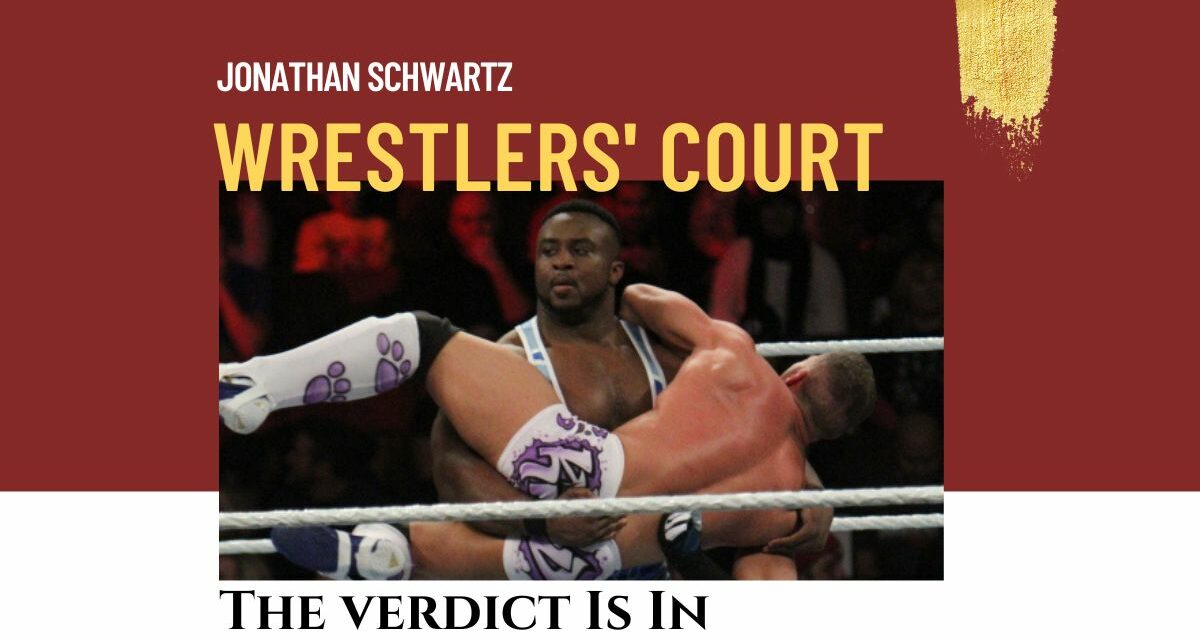On the July 4, 2023, edition of Corey Graves’ After the Bell WWE-approved podcast, former WWE champion and New Day pillar Big E (Ettore Ewen) offered an update regarding his broken neck. You may remember that he sustained this injury more than a year ago at the hands of Ridge Holland during a SmackDown tag team match. Big E fractured his C1 and C6 vertebrae.
On Graves’ show he reiterated that he is mostly healed, but that the break has been slow to ossify, which would provide better protection against what would be a catastrophic subsequent injury. He said that he feels well, is pain-free and noted that his mobility and strength have returned. He was less confident regarding a potential return to in-ring action, saying he still couldn’t provide a timetable or say whether he would ever wrestle again.
Unfortunately for wrestling fans, Big E’s prognosis has not improved. When asked again about a potential return during a SummerSlam press conference, Big E said that he had spoken with spine specialists who had worked on other WWE superstars and performed career-extending fusion surgeries on them, and that their advice was to not return to the ring. Big E was clear that he had not made any final decisions about a potential comeback but noted that at 37 years old he was more concerned about his health and quality of life going forward.
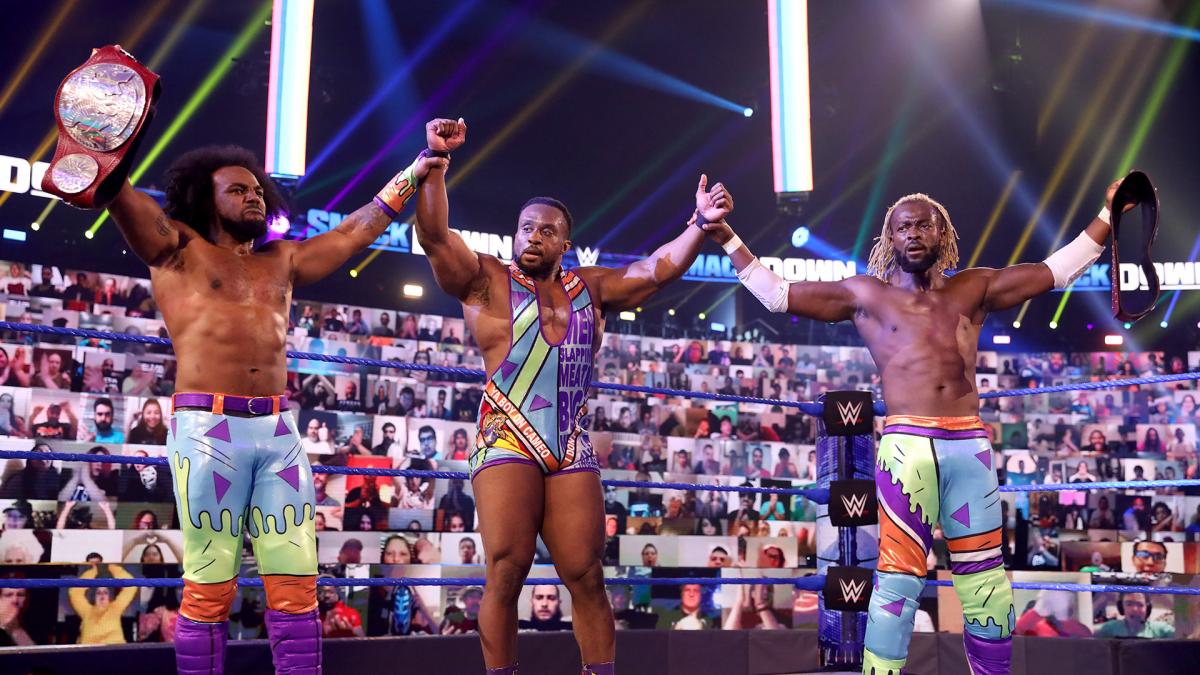
The New Day
As a fan, I’m disappointed. From his time at NXT where he won their title rehashing King Kong Bundy’s old ‘five count’ gimmick (which made me a fan for life) to his work alongside Dolph Ziggler and AJ Lee, to his first Intercontinental championship run as a babyface and then his breakout work with the New Day, I appreciate his work. I’m even more impressed with his continued commitment to developing his character and engaging his audience. Big E’s post New Day solo run was unfortunately curtailed, but it showed he could carry a title by himself; first the Intercontinental Belt, then a too-brief run as WWE Champion. I think Big E deserved a longer first world championship run, and that he could and should have been placed in credible programs alongside then-dominant heavyweights like Bobby Lashley, Drew McIntyre or Roman Reigns. I still believe that if Big E could come back safely, the story of his return from injury is compelling enough to make him the man who finally beats Reigns.
For now, life has other plans.
If Big E’s in-ring career is finished, I will be eagerly watching to see what he does next. Since finding his public voice as part of the New Day faction, Big E has shown a thoughtful, quirky charisma that resonates inside and outside pro wrestling. Big E had a life before wrestling, He played college football and still loves the game (he has acted as a public address announcer and hype man for a few college football teams). He was a championship powerlifter who was recruited to pro wrestling by Mark Henry. He has appeared on several WWE television programs and was often the funniest part of the New Day’s insightful podcast (it went out of production in 2022 after Big E won the WWE championship, but it’s still worth a listen). Big E has done voice work on extra-WWE projects as well, including a two-year run on a show called Lazor Wulf. He has been spotted helping new talent at WWE’s Florida Performance Centre as well.
Most recently, Big E has been asked about a possible role doing color commentary. Noting that fellow wrestler Titus O’Neil has started calling occasional matches, Big E acknowledged that the subject had been raised.
If I could ask for anything outside an in-ring comeback, I’d love to hear Big E on commentary-at least until he scores a more lucrative Pat McAfee deal elsewhere.
Historically, I would have suggested he run screaming from such an option — WWE’s recent practice under Vince McMahon was for the owner to feed his commentators lines over a headset while the show was in progress, and to curse them out when displeased live on-air. McMahon was known to be difficult with his announcing talent and burned out a bunch of color commentators this way, including the likes of JBL, Taz(z) and Mick Foley. If you watch any of their first few months on the job, each man brought something different to the announce booth, based on their own experience and characters. Within weeks to months, they were reduced to perpetual RONCO infomercial machines, often ignoring the action in the ring in favor of hyping the next pay-per-view or merchandise opportunity.
WWE commentary has long been a sore spot for me. I missed the ad libs that made old-school commentators so much fun and, when not trolling for column material I’ll often watch wrestling with the sound off… but with Vince out with his own alleged spinal surgery, perhaps there’s more breathing room for someone like Big E to make the role his own. Michael Cole has already spoken about the relief he’s felt under Triple H’s creative regime, and how it has reinvigorated him. And Cole is one of the few people to have thrived with Vince over his shoulder.
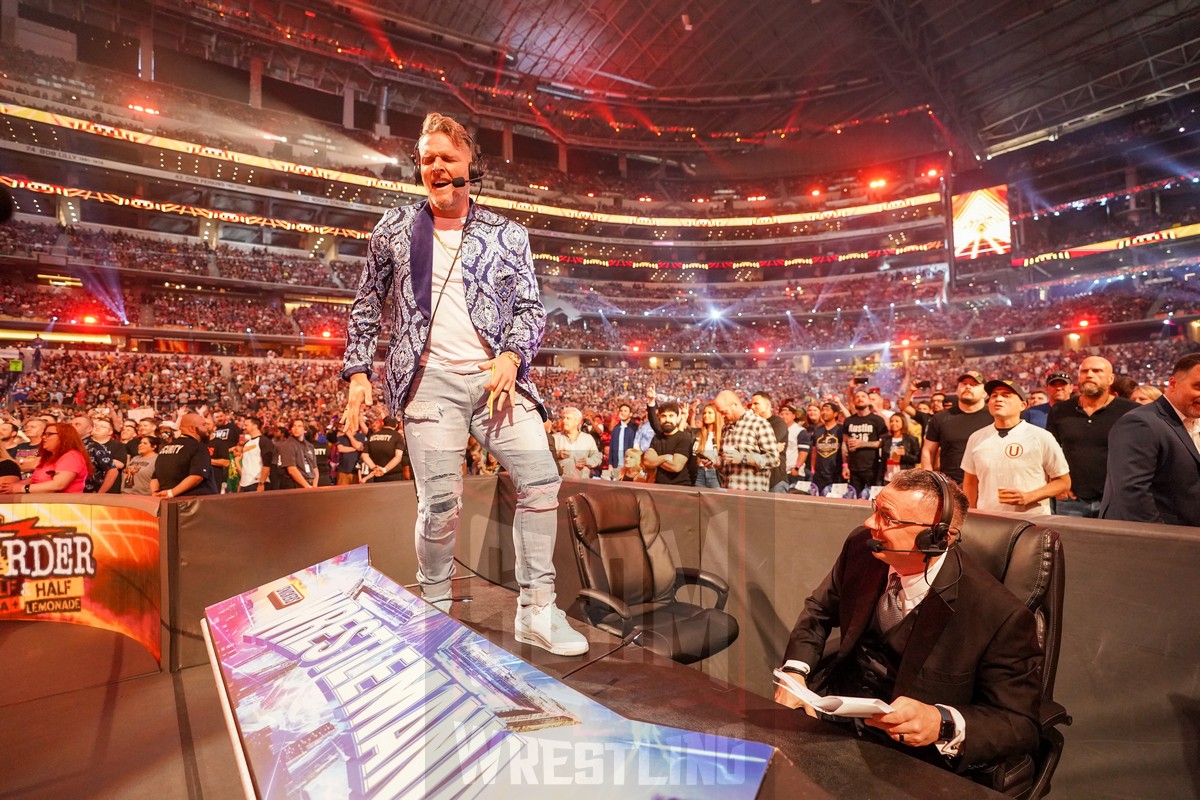
Announcers Pat McAfee and Michael Cole at WrestleMania 38 at AT & T Stadium in Arlington, Texas, on April 2, 2022. WWE photo
At their best, a former pro wrestler invests his or her own experience into the action being described, providing history, context and continuity. Back when pro wrestling was presented as more authentic, this grizzled approach to commentary added depth and reality to an unreal show. Using former wrestlers often seems to work better than attempts to bring in more ‘credible’ broadcasters from the sports or entertainment world.
Former football player/broadcaster Mike Adamle was a disaster in a series of on-screen roles, including as analyst on WWE’s version of ECW and RAW. Standup comedian Rob Bartlett was an early part of RAW’s broadcast team but was quickly removed. The less said about former radio DJ Todd Pettengill the better. More recently WWE has experimented with better-known sportscasters like Adnan Virk or Jimmy Smith. Neither man lasted long in the role; they often come across as unprepared (egregiously so in Mike Adamle’s case) and, coming from ‘legitimate’ sports backgrounds they seem to struggle not to wink at their audience over the dramatic parts of the program. Commentary must be a hard job, balancing the need to present matches as athletic contests with the equally important job of acting as Greek Chorus to make sense of the soap opera that informs those matches. The most successful non-wrestling commentators either play it completely straight, like Gordon Solie or Ed Whalen, or dive head first into their own status as fans, and make their honest reactions part of the show, like St. Louis’ Mickey Garagiola or Pat McAfee. Garagiola and McAfee weren’t going to explain the nuances of a wristlock, but their enthusiasm was infectious.
Before wrestling went national, WW(W)F fans might remember the likes of ‘Nature Boy’ Buddy Rogers’ or Pat Patterson’s forays into color commentary. If your working memory starts in the mid-1980s, you most likely grew up listening to the likes of Gorilla Monsoon and Bruno Sammartino calling the action (and extolling the virtues of fair play) while heels Bobby “The Brain” Heenan and Jesse “The Body” Ventura got all the fun lines.
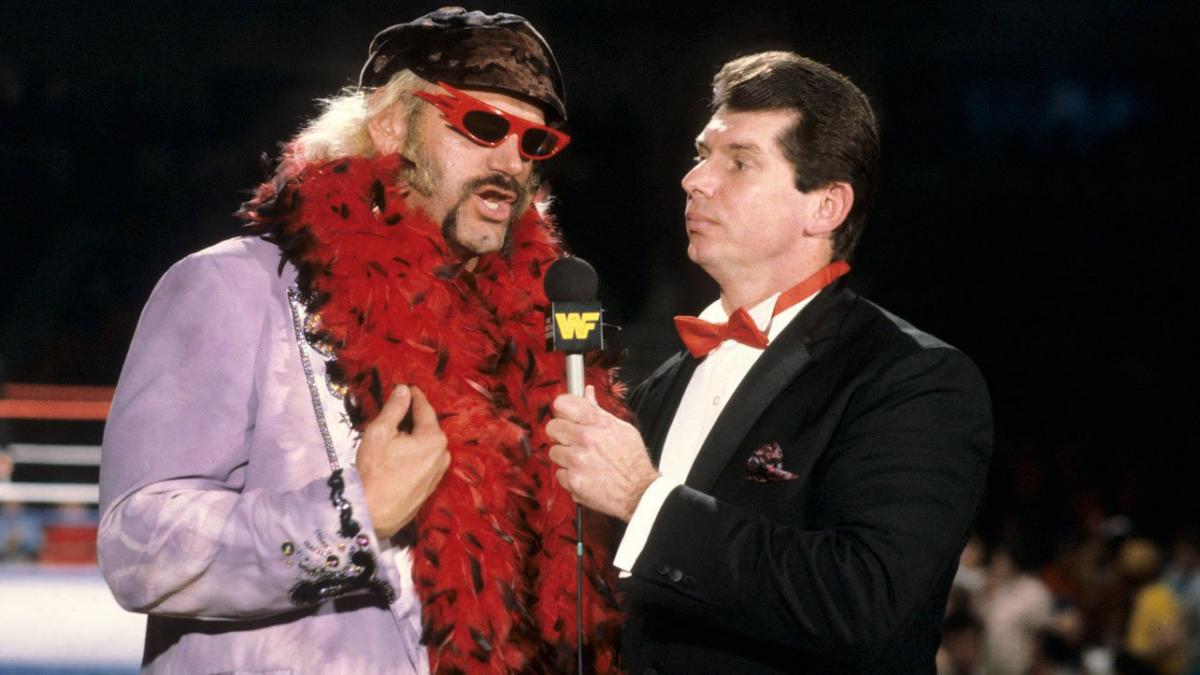
Jesse Ventura and Vince McMahon.
Heenan and Ventura are credited with the rise of the heel color commentator — although I’ll argue that may be because wrestling history is written by the McMahons. The heel commentator provides a skewed analysis of the action which favors the rule-breaking wrestler of the moment and makes fun of the good guys. I believe that this role attracts and keeps older fans. If you’re like me, you became a wrestling fan during the Rock ’n’ Wrestling era, when WWF rewrote pro wrestling from a quasi-legitimate contest between athletes to a full-on comic book come to life. Flashy, one-dimensional good guys like Hulk Hogan or Junkyard Dog or Jimmy “Superfly” Snuka (which feels creepy and sad to write now, given what we know about all three men) would appeal to younger kids as they took on ever more sinister ‘big bad’ heels. But the formula would grow tired quickly, the same way kids grow out of superheroes and leave the genre altogether without more challenging storylines and characters.
Over time, comic books evolved to give more sympathetic readings to villains like the Joker or Galactus or Darkseid. Similarly, pro wrestling has shaded its villains at least a little bit more by having Paul Orndorff betray Hulk Hogan after feeling ignored by his supposed friend’s glory-hogging, or Andre the Giant betray Hogan over Hogan’s refusal to grant him an up-and-up title match, or Randy Savage betray Hogan over his credible assertion that Hogan “lusted after Elizabeth”. The latter has made its way into some real life accounts of Hogan and Savage’s tumultuous relationship, and Hogan’s behavior since retiring suggests that he deserved all of these betrayals and more. Even Brutus Beefcake’s.
Heel commentators like Heenan and Ventura helped bring the bad guys’ viewpoints to light and justified their attempts to cheat. Their bent takes on the very unreal world of pro wrestling led to some awesome primary process comments, like “win if you can, lose if you must, always cheat”, “it ain’t cheating if you don’t get caught” or “a friend in need is a pest”, all of which I use in meetings at my real job.
At some point in our fandom many of us realize that the bad guys just have more fun, and we start cheering for them instead of the good guys. Heenan in particular was so good in his role as Hulk Hogan’s antagonist that he kept the bit going through WC, raging at Hogan’s fake good guy persona. When Hogan finally turned heel and founded the New World Order, Heenan nearly spoiled the heel turn asking “who’s side is he on?” as Hogan made his way to the ring. When Hogan formally joined up Heenan called out Hogan’s hypocrisy, using the turn to show he’d been right about the Hulkster all along. Heenan stayed committed to his heel act, but still couldn’t bring himself to cheer the man who became the worst bad guy of them all. It was great storytelling.
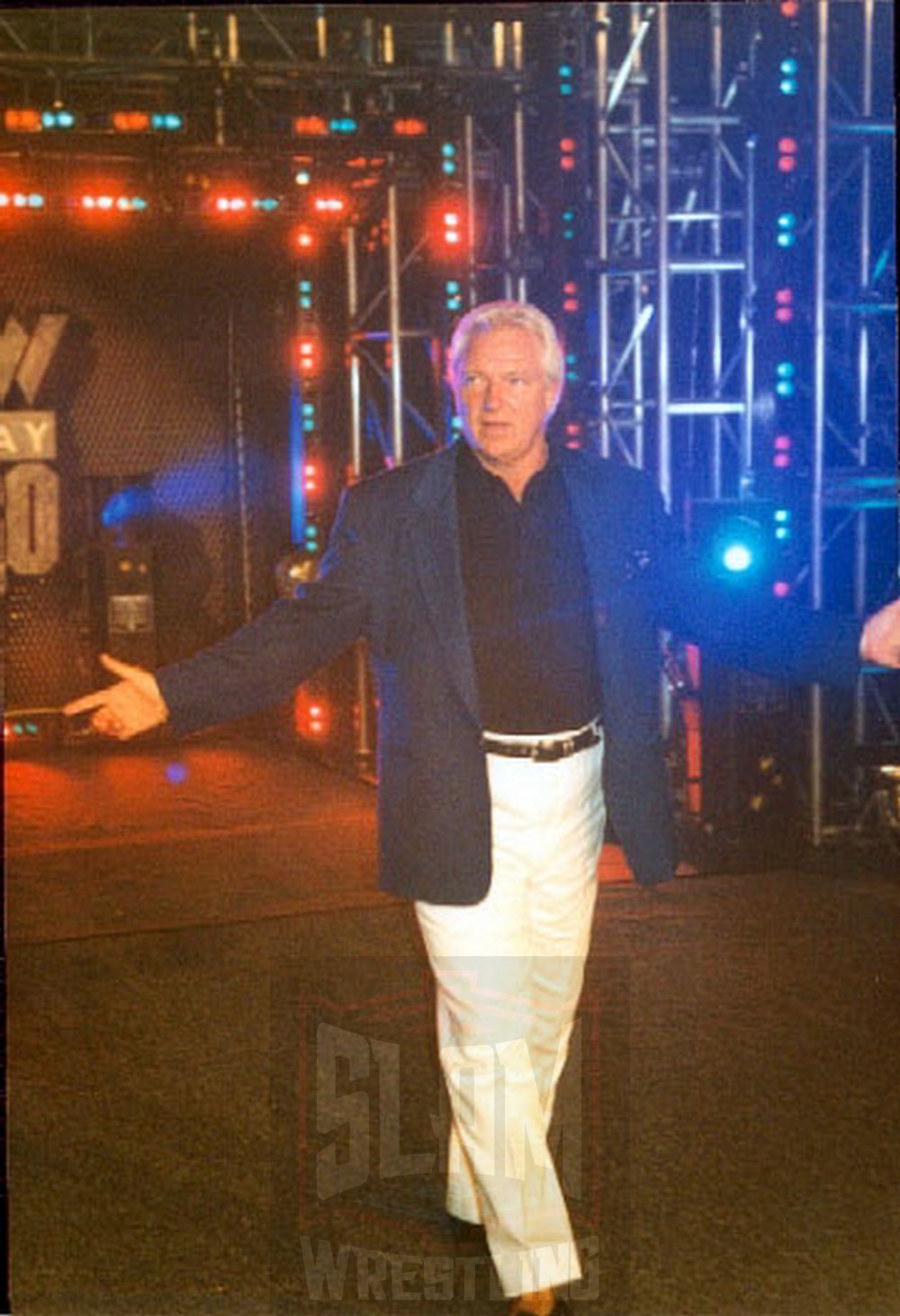
Bobby Heenan in WCW. Photo by Mike Lano, WReaLano@aol.com
I don’t think Big E will turn heel for the sake of a commentary career but note that Heenan expanded his commentary role and limited his managerial appearances after suffering a legitimate neck injury. Like Big E, Ventura was prematurely retired from active competition, having been diagnosed with blood clots that he later claimed arose following exposure to the defoliant Agent Orange in Vietnam.
There are fewer examples of babyface commentators. they generally play straight man to the heels, but there are some notable examples. Gorilla Monsoon was a fearsome giant heel in the WWWF. In 1969 he turned babyface and remained a beloved character until he retired in the early 1980s. Monsoon, who had sold his ownership stake in the WWF to Vince McMahon to facilitate its expansion, had a lifetime gig behind the scenes and on commentary. He would be paired with Jesse Ventura as the ‘voice of reason’ supporting fan favorites while Ventura cheered for the heels. Monsoon’s approach could be critical of babyfaces, and he would call out silly or repetitive spots and occasionally side with the heels. I would suggest that while Monsoon and Ventura set the standard for modern wresting commentary, their work was eclipsed by Monsoon’s chemistry with Heenan.
At points Monsoon, or McMahon and Ventura would be paired with former World Champion Bruno Sammartino. Sammartino might have been positioned as the ultimate babyface commentator, but he never seemed comfortable in that role. Bruno had all the bona fides to tell a compelling story — his 11 years as World Champion turning back a succession of heel challengers led by a conspiracy of managers made him a successful underdog despite his obvious strength… but audiences loved Bruno in part because he was humble and softspoken. Bruno could get mad, and Bruno would get even, but even in his most fiery promo designed to get himself and his opponent over, he rarely ventured beyond “doggone” territory. Bruno was protective of his clean living image, so much so that well after he retired, he supposedly turned down a role in The Sopranos because of the foul language that made up much of the show’s dialog. Bruno’s relatable, working-man character wasn’t far off the man himself, and fit poorly with the increasingly cartoonish WWF of the 1980s.
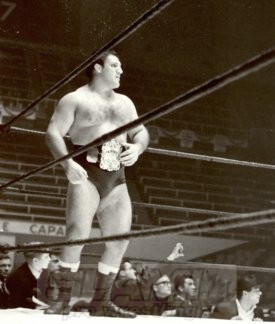
WWWF World champion Bruno Sammartino in Toronto. Photo by Roger Baker
As a color man Bruno would occasionally speak to the action in the ring, but more often scolded the bad guys when they cheated or worse, took advantage of his son, aspiring wrestler David Sammartino. Ironically Bruno’s best use came when he would be so offended by a new star like Brutus Beefcake, Roddy Piper, Randy Savage or Adrian Adonis, that he would get back in the ring for vengeance. Sammartino has claimed that while he had long since lost interest in wrestling, he was pushed into these matches to shore up attendance and make Hulk Hogan look like a bigger star than he was. Bruno was a great champion, but a limited and ultimately disinterested commentator, who would find himself deeply estranged from the WWF/WWE, the business as a whole, and even his own son over what he saw as a turn to trash television. Still, as a former wrestler he opened up storyline possibilities if he could be goaded into a match. Take that, Art Donovan.
Speaking of Randy Savage, the Macho Man transitioned to color commentary in 1991 following his “career ending” WrestleMania loss to the Ultimate Warrior. At first, Savage was an odd fit on commentary given his his gravel voice and syncopated speech patterns. But it worked, in part due to the seriousness with which Savage approached every part of the wrestling business. Savage understood the importance of getting other talent over, and in the tradition of the best color analysts he could explain the psychology behind the match and advance storylines without sounding hokey. Savage would eventually be reinstated as a wrestler, but would return to the commentary desk in January 1993 as part of the inaugural Monday Night Raw announce team. He would still wrestle, but by October 1994 would leave the WWF for good. Wrestling fans have long speculated about his departure. One theory suggests that Savage was upset over being consigned to commentary because Vince McMahon decided he was too old to wrestle. Today, age seems more like a number than ever in wrestling given how many 40, 50 and even 60 plus wrestlers (salt and) pepper WWE supercards.
“Rowdy” Roddy Piper was another unconventional babyface commentator. Piper actually had a run as a heel commentator in Georgia Championship Wrestling (one of WCW’s precursors) from 1981 to 1982. That role would eventually turn Piper good, when he came to the aid of his play-by-play man Gordon Solie, who was being harassed by the “Magnificent” Don Muraco. (Jerry Lawler would occasionally turn face in WWE a few times under similar circumstances, defending helpless play-by-play men like Jim Ross and Michael Cole.) Piper’s verbal skills landed him a series of jobs, including with the WWF where he was considered small by Vince McMahon’s standards, and initially positioned as a manager/Piper’s Pit host. Piper would co-host Prime Time Wrestling intermittently from 1989-1991, mainly to advance his feud with “Ravishing” Rick Rude.
Piper’s antic promo style translated well to commentary and led to occasional lapses in kayfabe that suited his ‘loose cannon’ persona and added interest to a waning version of pro wrestling. The best example came during the debut of ‘Saba Simba’ a supposedly ‘African’ character played by former tag team champion and bodybuilder Tony Atlas, who was said to have ‘returned to his roots’ and come back to the WWF in full headdress, loin cloth and spear. Piper, who had his own history of misjudging racial stereotypes (including fighting bad News Brown in half-blackface at a WrestleMania), no-sold the character and blurted out “That’s Tony Atlas!”
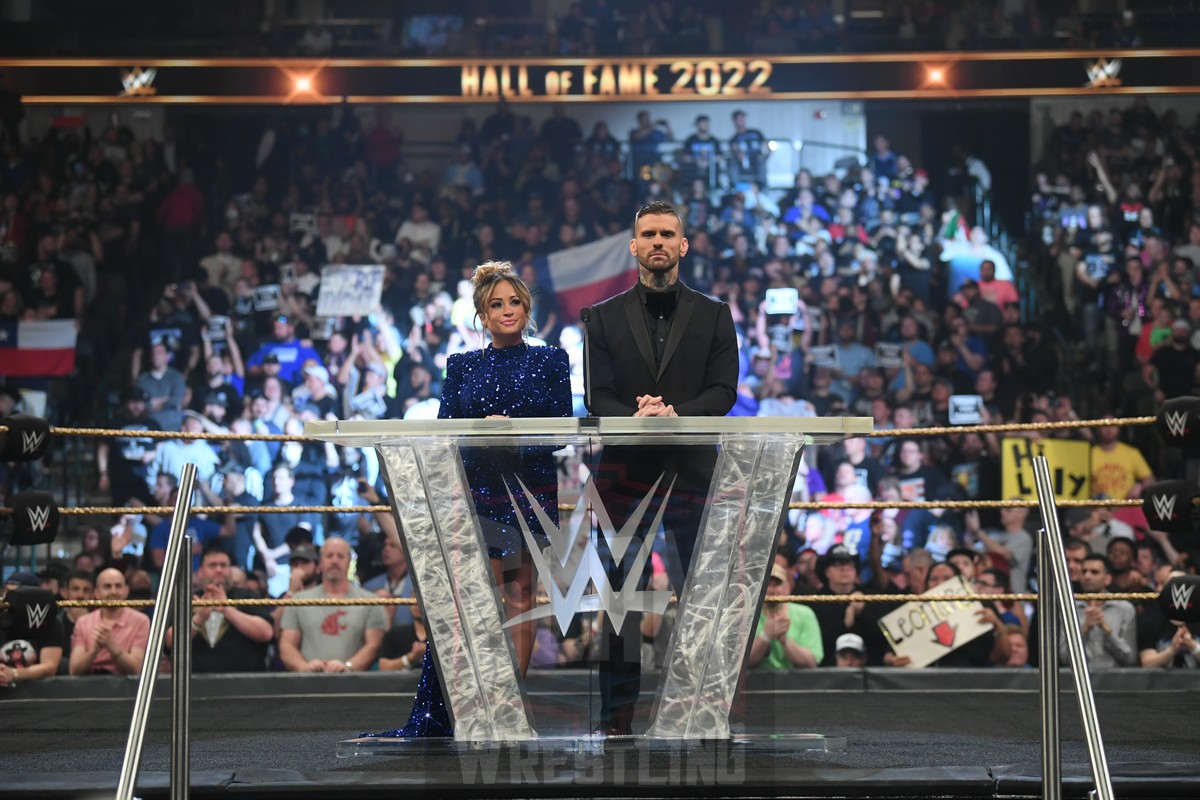
Hosts Kayla Braxton and Corey Graves at the WWE Hall of Fame ceremony on Friday, April 1, 2022, at the American Airlines Center in Dallas, Texas. WWE Photo
A quick look at WWE commentary over the years offers many examples of wrestlers who retired or were forced out of the ring by injury. I would argue that many of these ex-wrestlers extended their WWE runs well after they would otherwise have been released. Current broadcast team member Corey Graves spent three years wrestling in NXT under a CM Punk-adjacent gimmick. He was forced to retire due to concussions in 2014 but has solidified himself as a soft-heel color commentator across all three WWE brands. Byron Saxton was signed in 2007 and participated in two seasons of NXT as a ‘rookie’ back when it was a quasi-reality show. He credits Dusty Rhodes (who was a fantastic babyface commentator on WCW’s Saturday Night shows — even if my idea of fantastic swaps coherence out in favor of an innovative approach to language with classics like “clubberin’”, “plunder”, “mother ship” and “pay winda”. I use these in meetings too. I love my job) with his move to the announce booth. Saxton has been on the broadcast team since 2012, although he’s quiet enough that you’d barely notice him.
Before them, Matt Striker’s heel teacher act quickly wore thin as a wrestler, but his ability to break concepts down simply for the audience at home (and incorporate lines as screamed over a headset by his boss) led him to a five-year WWE commentary career from 2008-2013. Striker has gone on to work with Major League Wrestling, Impact Wrestling and Lucha Underground, pivoting from straight play-by-play to heel analyst as required.
In Lucha Underground, Striker was paired with Vampiro — himself a popular former heel with decades of experience. Outside of WWE, this is one of my all-time favorite announce teams since both men could speak directly to how a match could be put together and why a move might hurt. The Striker-Vampiro pairing was especially effective given the team’s total commitment to the gonzo reality of the Lucha Underground universe.
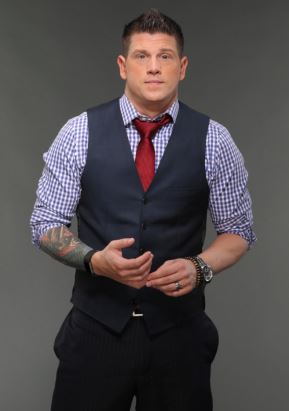
Josh Mathews
Striker’s SmackDown partner Josh Mathews was another NXT reality show alumnus who quickly transitioned to a backstage interviewer role, then to commentary from 2006-2014. He has been with Impact Wrestling in various backstage positions ever since.
Even Jerry Lawler, a former AWA World champion and Memphis legend, failed to make an impact in the WWF as a wrestler, but has been a vital part of its commentary team since the Attitude Era. I’ve never been a fan of Lawler’s color work. To me he always brought the spotlight back to himself, his few catchphrases, and an approach to women that would now be considered cancellable. He had (and has) a rabid fan base, but his wrestling never attracted notice on wrestling’s biggest stage unless he was piledriving comedians. His WWE broadcasting run lasted from 1992-2016 (with a few hiatuses along the way), and as recently as 2020 he would be brought back to the RAW commentary team.
Of course, not every ex-wrestler will excel at the commentary booth. “Superstar” Billy Graham was a marvel at getting himself over as an in-ring performer, but his gift of gab failed him when tasked with convincing fans to buy tickets to see other performers. Between 1988 and 1989 Graham provided color commentary on WWF television broadcasts, including the first SummerSlam card. I remember looking forward to his performance, given how entertaining his promos were. I was disappointed by what felt like a borderline-incoherence, lowlighted by his apparent lack of knowledge about his fellow wrestlers or their storylines and the immortal line “he shattered his helmet”. Pronouns, pal, indeed. To be fair, Graham spent much of that time in and out of surgeries to repair his crumbling body. Over the next few years he would personally sue the McMahon family and Dr. George Zahorian in the wake of WWF’s steroid scandal, and would make damning allegations of sexual abuse by WWF employees. Graham’s lawsuit would fail, and he would later recant his claims of abuse, admitting that they were part of a clumsy extortion scheme.
Michael “P.S.” Hayes was similarly a great talker, and as the mouthpiece for the Fabulous Freebirds he led plenty of fans into arenas on Terry Gordy and Buddy “Jack” Roberts’ behalf. Hayes also contributed color work to WCW broadcasts during his later run alongside Jimmy Garvin. Drafted to the moribund early 1990s WWF as “Dok Hendrix” following his own career-ending back injury, Hayes was stripped of the character that made him special. In the announce booth he could offer some kind of analysis, but without the context of his decades raising hell in the ring, he fell flat. Hayes’ tenure as Hendrix is still best known for his standing mutely by as “Stone Cold” Steve Austin spewed his seminal “Austin 3:16” speech at the 1996 King of the Ring pay-per-view. Hayes found an outlet for his creativity as a road agent and a senior member of WWE’s writing team since 2006. Hayes would occasionally return to the commentary booth under his “Purely Sexy” ring name in 2000-2001 alongside Kevin Kelly and Michael Cole, but that was for the international version of Sunday Night Heat.
Johnny Polo suffered from a similar identity crisis when he was brought in as a heel commentator. Polo had worked extensively in Memphis, Portland and WCW under various guises. He was recast as a generic spoiled rich kid and offered standard heel insights while also managing the likes of Adam Bomb and the Quebecers. Today, the best we can ask is “what about him?”
Over the years a host of former wrestlers have taken turns at the announce booth, with varying degrees of success. From career enhancement talent Pete “The Duke of Dorchester” Doherty, to former Kings of the Ring Wade Barrett and Booker T, to “Lords” Alfred Hayes and Tensai. Former champions like Sammartino, Graham and Savage, would-be WWF/E champions like Curt Hennig and Ted Dibiase, to genuine head-scratchers like Jim “The Anvil” Neidhart, Hillblly Jim or Sho Funaki have all contributed to the shows we love.
Finally, I think it’s important to note what Big E would bring to the commentary booth in terms of representation. I won’t go into my usual excruciating detail here but will point out that WWE has long struggled with effectively representing different groups in ways that are not ultimately stereotypical or offensive. While WWE has had many racialized performers, it seems like few of them stick around once their wrestling days are done. Of late, that’s getting better. Titus O’Neil has been a bright spot for WWE in any role they’ve given him. Titus has sat in on commentary on a few occasions and acquitted himself well — he radiates positivity on screen and brings a football player’s approach to describing the nuances of a match or storyline. In recent years WWE has tried to make its announce team more diverse: the aforementioned Byron Saxton has been featured for a while, but rarely makes an impression. Percy Watkins and Dio Maddin were both solid in the role, but were quickly moved on to other projects, or out of the company completely. I still don’t understand why David Otunga isn’t calling RAW or SmackDown. He’s a freakin’ lawyer. We’re the best.
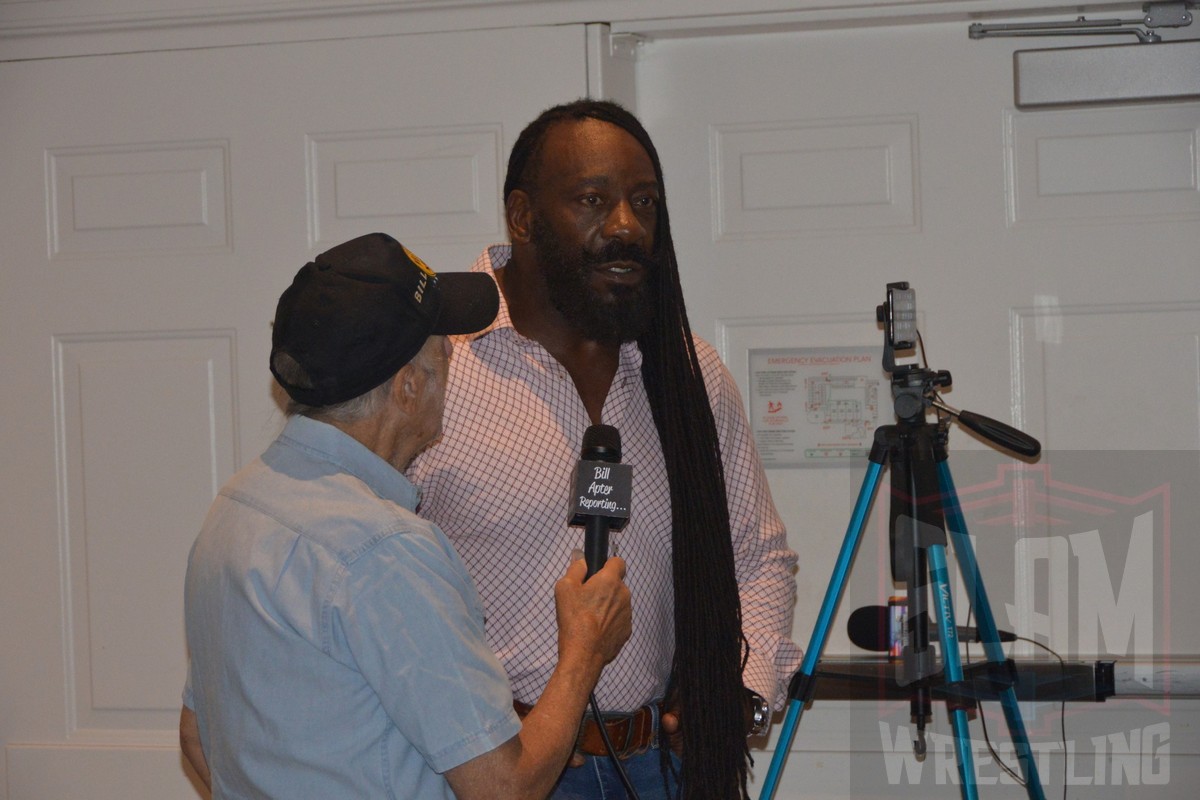
Bill Apter interviews Booker T at the International Professional Wrestling Hall of Fame induction weekend on Saturday, August 27, 2022, at the Desmond Hotel, in Albany, NY. Photo by Wayne Palmer
So far as credible former wrestlers go who might offer different perspectives, the only consistent commentator seems to be Booker T — who has worked across RAW, SmackDown and currently NXT. And with utmost respect he’s awful. I loved Booker as a wrestler and enjoyed his promo work whether he was part of Harlem Heat or King Bookah. I respect that he has opened a successful training school, which has produced several current stars. But on commentary so far he is a liability — growling catch phrases that have nothing to do with anything. I could totally be missing something, but if Booker could explain “Awwwww Shucky Ducky Quack Quack” to me I would be grateful and readily change my mind about his commentary. Until then, my opinion stands. If feuding commentators is an option, Booker T has made his dislike of Big E’s use of the word “sucka” in the latter’s promos known. If Big E joined a commentary team and ultimately rejoined the active roster, we could have a worthy successor to the Michael Cole-Jerry Lawler WrestleMania match that nobody wanted to see.
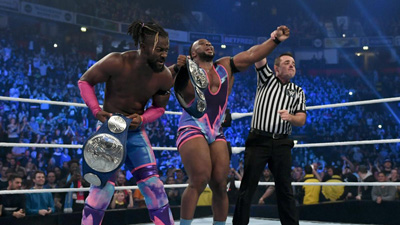
Bringing Big E to commentary would help any broadcast. The man knows how to get himself and his opponents over and has shown that he is equally adept at soft-spoken serious promos and outright silliness. More important, as the New Day evolved and during his short singles run, Big E took the opportunity to educate his audience and promote tolerance and respect across cultures. Early in his singles run he went so far as to include pictures of historically significant Black Americans on his ring gear… and for what it’s worth, it worked. I googled them and learned a lot. Big E has a voice worth hearing. He deserves the best platform he can find.
I’m no doctor, but wrestlers from Steve Austin to Kurt Angle to Edge (twice) to Daniel Bryan to Christian have all come back from serious, career-ending injuries, including in some cases spinal injuries. Some of those returns were years in the making, and maybe Big E has decided to see what life after wrestling can offer. More power to him if so. The more I learn about the world of pro wrestling the more I think that the true test of success within this business is how well one escapes it. I’m also mindful that as inspiring as those stories may be, pro wrestling has its share of bad endings too, like Chris Benoit or Darren “Droz” Drozdov, who recently passed away. I wouldn’t wish any further harm to Big E or any other wrestler.
And I hope whatever his next move may be, he brings the same intensity and enjoyment that he has to his work thus far.
TOP PHOTO: Big E from the January 2015 Royal Rumble show. Photo by George Tahinos, https://georgetahinos.smugmug.com
RELATED LINK
